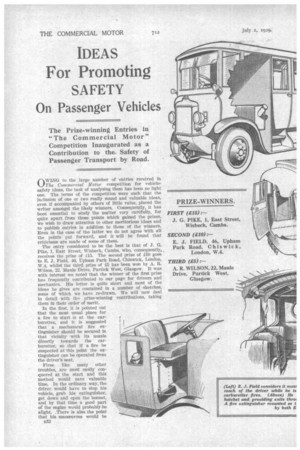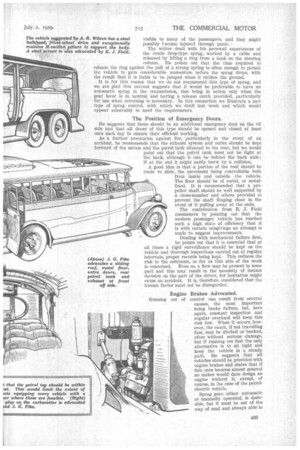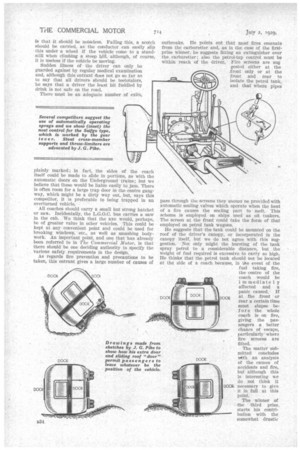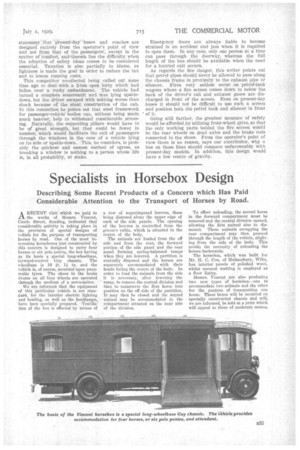IDEAS
Page 58

Page 59

Page 60

Page 61

If you've noticed an error in this article please click here to report it so we can fix it.
For Promoting
SAFETY On Passenger Vehicles
OWING to the large number of entries received in The Commercial Motor competition for vehiclesafety ideas, the task of analysing them has been no light one. The terms of the competition were such that the inelusion of one or two really sound and valuable ideas, even if accompanied by others of little value, placed the writer amongst the likely winners. Consequently, it has been essential to study the matter very carefully, for quite apart from those points which gained the prizes, we wish to draw attention to other meritorious ideas and to publish entries in addition to those of the winners. Even in the case of the latter we do not agree With all the points put forward, and it will be found that criticisms are made of some of them.
The entry considered to be the best is that of J. G. Pike, 1, East Street, Wisbech, Cambs, who, consequently, receives the prize of 1.15. The second prize of ati goes to E. J. Field, 40, Upham Park Road, Chiswick, London, W.4, whilst the third prize of £5 has been won by A. R. Wilson, 22, Maule Drive, Partick West, Glasgow. It was with interest we noted that the winner of the first prize has frequently contributed to our page for drivers and mechanics. His letter . is quite short and most of the ideas he gives are contained in a number of sketches, some of which we have re-drawn. We will now deal in detail with the prize-winning contributions, taking them in their order of merit.
In the first, it is pointed out that the most usual .place for a fire to start is at the carburetter, and it is suggested that a mechanical fire extinguisher should be secured in that vicinity with its nozzle directly towards the carburetter, so that if a fire be suspected at this point the extinguisher can be operated from the driver's seat.
Fires. like many other troubles, are most easily conquered at the start and this method would save valuable time. In the ordinary way, the driver would have to stop his vehicle, grab his extinguisher, get down and open the bonnet, and by that time a good part of the engine would probably be alight. .There is also the point that his manceuvres would be n32 visible to many of the passengers, and they might possibly tecome injured through panic. • The writer dealt with his personal experiences of the crude drop-type sprag, worked by a cable and released by lifting a ring from a hook on the steering column. He points out that the time required to release the ring against the pull of a strong spring is often enough to permit the vehicle to gain considerable momentum before the sprag drops, with the result that it is liable to be jumped when it strikes the ground. It is for this reason that we do not recommend this type of sprag, and we are glad this entrant suggests that it would be preferable to have an automatic sprag in the transmission, this being in action only when the gear lever is in neutral and having a release catch provided, particularly for use when reversing is necessary. In this connection we illustrate a new type of sprag control, with which we dealt last week and which would appear admirably to meet the requirements.
The Position of Emergency Doors.
He suggests that there should be an additional emergency door on the off side and that all doors of this type should be opened and closed at least once each day to ensure their efficient working.
As a further precaution against fire, particularly in the event of an accident, he recommends that the exhaust system and outlet should be kept forward of the saloon and the petrol tank situated to the rear, but we would point out that the petrol tank must not be right at the back, although it can be behind the back axle; if at the end it might easily burst by a collision.
A good idea is that a portion of the roof should be made to slide, the movement being controllable both from inside and outside the vehicle. The Moor should be of metal, or metallined. It is recommended that a propeller shaft should be well supported by a cross-member and others provided to prevent the shaft flinging clear in the event of it pulling away at the ends.
The contribution from E. J. Field commences by pointing out that the modern passenger vehicle has reached such a high state of efficiency that it is with certain misgivings an attempt is made to suggest improvements.
Dealing with mechanical failure first, he points out that it is essential that at all times a rigid surveillance should be kept on the venicle and thorough inspections carried out at regular intervals, proper records being kept. This reduces the risk to the minimum, so far as this side of the work is concerned. Even so, a flaw may be present in some part and this may result in the necessity of instant decision on the part of the driver, for hesitation might cause an accident. It is, therefore, considered that the human factor must not be disregarded.
Engine Brakes Advocated.
out of control •can result from several causes, the most important being brake failure, but, here again. constant inspection and regular overhaul will keep this risk low. When it occurs, however, the coach, if not travelling fast, may be ditched or banked, often without serious .damage, but if running too fast the only alternative is to sit tight and keep the vehicle in a .steady path. He suggests that all vehicles should be provided with engine brakes and states that if this once became almost general no maker would dare design an engine without it, except, of course, in the case of the petrolelectric vehicle.
Sprag gear, either automatic or manually operated, is desirable, but it must be out of the way of mud and always able to is that it should be noiseless. Failing this, a scotch should be carvied, as the conductor can easily slip . this under a wheel if the vehicle come to a •standstill when climbing a steep bill.• although, of course, it is useless if the vehicle be moving.
Sudden illness of the driver can only be guarded against by regular medical examination and, although this entrant does not go so far as to say that all drivers should be teetotalers, he says that a driver the least bit fuddled by drink is not safe on the road.
There must be an adequate number of exits,
plainly marked; in fact, the sides of the coach itself could be made to slide in portions, as with the automatic doors on the Underground trains; but we believe that these would be liable easily to jam. There is often room for a large trap door in the centre gangway, which might be a dirty way out, but, says this competitor, it is preferable to being trapped in an overturned vehicle.
AU coaches should carry a small but strong hatchet or saw. Incidentally, the L.G.O.C. bus carries a saw in the cab_ We think that the axe would, perhaps, be of greater value in other vehicles. This could be kept at any convenient point and could be used for breaking windows, etc., as well as smashing bodywork. An important point, and one that has already been referred to in The Commercial Motor, is that there should be one deciding authority to specify the various safety requirements in the design.
As regards fire prevention and precautions to be taken, this entrant gives a large number of causes of outbreaks. He points out that most fires emanate from the carburetter. and, as in the case of the firstprize winner, he suggests fitting an extinguisher over the carburetter; also the petrol-tap control must be within reach of the driver, Fire screens are sug e‘eted either at the .front only or at the front and rear to isolate the petrol tank, and that where pipes pass through the screens they should ne provided with automatic sealing valves which operate when' the heat of a fire causes the sealing part to melt. This scheme is employed on ships used as oil tankers. The screen at the front could take the form of that employed on petrol tank wagons. .
He suggests that the tank could be mounted on the roof of the driver's canopy, or incorporated in the canopy itself, but we do not agree with this suggestion. Not only might the bursting of the tank spray petrol to a considerable distance, but the weight of fuel required is excessive to carry so high. He thinks that the petrol tank should not be located at the side of a coach because, in e event of the fuel taking tire, the centre of the coach would be
m mediate 1 y affected and a panic caused. If at ihe front or rear a certain time must elapse before the whole coach is on fire, giving the passengers a better chance of escape, particularly' where tire screens are fitted.
The matter submitted concludes th an analysis of the causes of accidents and fire, but Although this Is interesting we do not think it necessary to give it in full at this point.
The winner of the third prize, starts his contribution with the somewhat drastic
statement That .`Prese.nt-day''huses and coaches are designed entirely from the operator's point. of view and not from that of the passengers', except in the .matter of 'Comfort, .anditherein lies the difficulty when the adoption of safety ideas comes to be considered essential. Taxation is also partially to blame, as lightness is made the goal in order to reduce the tax
and to lessen running costs. •
This competitor recollected being called out Some time ago to deal with a 2-ton open lorry which had fallen over a rocky embankment. The vehicle had turned a complete somersault and was lying upsidedown, but the driver escaped with nothing worse than• shock because of the stout construction of the cab. In this connection he points out that steel framework for passenger-vehicle' bodies can, without being made much heavier, help to withstand considerable . stressing. Naturally, the supporting pillars would have to be of great strength, but they could be fewer in number, which would facilitate the exit of passengers through the windows in the case of a vehicle lying on its side or upside-down. This, he considers, is probably the quickest and easiest method of egress, as breaking a window is nothing to a person whose life is, in all probability, at Stake.
Emergency doors are always liable to become strained in an accident and jam when it is required to open them. In any case, only one person at a time can pass through the doorway, whereas the full length of the bus should be available when the need for a hurried exit occurs.
As regards the fire danger, this writer points out that petrol pipes should never be allowed to pass along the chassis frame in proximity to the exhaust pipe or silencer. Fires very seldom occur on petrol-tank wagons where a fire screen comes down to below the back of the driver's cab and exhaust gases are discharged in front of the screen. Even on present-day buses it should not be difficult to use such a screen and position both the petrol tank and silencer in front of it.
Going still farther, the greatest measure of safety would be afforded.by utilizing front-wheel drive, so that the only working parts behind the fire screen would be the rear wheels on dead axles and the brake rods connected to the shoes. From the operator's point of view there is no reason, says our contributor, Why. a bus on these lines should compare unfavourably with present-day models. In addition, this design would have a low centre of gravity.




















































































































